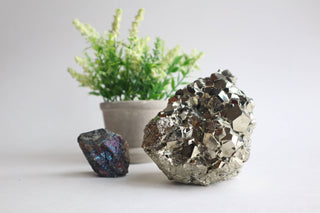Crystals are nature's marvels, intriguing us with their mesmerizing beauty and the secrets they hold about our planet's history. How are crystals formed in rocks? What processes in nature give birth to these intricate natural crystal formations? This guide answers important questions and explains how the healing properties of crystals can be traced back to their origin.
The Mysteries of Crystal Formation: What is a Crystal?
In essence, a crystal is a solid material wherein atoms find themselves in an orderly, repeating pattern, extending uniformly in all directions. But this definition merely scratches the surface. When one asks, "How do crystals form in nature?" or "How are rock crystals formed?", the journey delves deeper into Earth's processes, echoing tales of magma, pressure, and hydrothermal activities.
The Intricate Process: How Are Crystals Formed?
Unearthing the secrets of how crystals are formed paints a vivid picture of Earth's multifaceted processes. These formations are a testament to nature's artistry and patience.
🔥Crystallization from Magma:
As molten rock slowly cools down, the atoms within form structured patterns, giving rise to crystals. For instance, the vibrant Peridot is a gem born of magma, its green hues synonymous with the molten birthplace from which it arises.
💎Metamorphic Transformation: How are Crystals Formed Under Pressure?
Deep within the Earth's core, where immense pressures and temperatures are dominant, a magnificent transformation takes place. Existing rocks, subjected to these tremendous forces, undergo metamorphosis, giving birth to a diverse range of minerals and crystals.
Soapstone, primarily composed of talc and known for its soft texture, is a product of these intense metamorphic processes. Its ability to retain heat and resist chemicals makes it a favorite for crafting items like countertops and sculptures.
Likewise, the glistening mica emerges from deep within, showcasing the vast diversity of minerals birthed from the Earth's inner alchemy. Marble, beginning its journey as humble limestone, transforms under these pressures into its iconic, veined crystalline beauty. On the other hand, quartz, one of the most abundant and varied minerals on our planet, can also trace its lineage to these transformative processes deep within the Earth.
Each of these materials, unique in its properties and appearance, exemplifies the Earth's incredible capacity for creation and transformation, even under the harshest conditions.
🌊Hydrothermal Solutions: How Does a Crystal Grow Here?
This involves mineral-rich hot waters interacting with rocks. While Quartz is a notable example, Beryl, the mineral family that includes gems like emerald and aquamarine, often forms in these hydrothermal environments.
♨️Evaporative Formation:
In places where mineral-rich waters slowly evaporate, crystals start to emerge. Halite, commonly known as rock salt, forms when saltwater evaporates.
🌲Organic Formation:
Not all crystals come directly from inorganic processes. Amber, although not a crystal in the strictest sense, is organic, formed from the resin of ancient trees that has fossilized over millions of years. It's a testament to the diverse ways nature creates lasting beauty.
By understanding the myriad ways in which crystals emerge, we gain profound insights into the dynamic, ever-evolving world beneath our feet. The very processes that shape these gems offer lessons in patience, transformation, and the wonders of nature.
Unravelling Nature's Blueprint: Delving into Crystal Structures
How is Selenite Crystal Formed?
Selenite formed from ancient seas that gradually evaporated over time. This unique origin imbues it with a strong sense of purity and cleansing abilities.
You can use Selenite to clear energy blockages and foster spiritual growth.

How Are Quartz Crystals Formed in Nature?
Quartz is commonly found where hot, mineral-rich water meets its surroundings. This formation process makes quartz powerful in amplifying energies.
It's also great for attuning to various vibrations.

Obsidian Formation: How Are Crystals Formed Rapidly?
Obsidian has a unique and dramatic origin. It emerges when lava from volcanic eruptions cools down rapidly, freezing into a glass-like structure. This almost instantaneous transformation gives Obsidian its sleek, glassy appearance.
The speed and intensity of its formation imbue Obsidian with protective energies. Consequently, it's often utilized in spiritual practices as a shield against negative influences, mirroring its sudden and defensive birth from Earth's fiery depths.

Moldavite's Cosmic Birth
Moldavite is a rare gem created by the intense heat of meteoric collisions with Earth. As a result of this cosmic origin, it uniquely bridges the gap between terrestrial and extraterrestrial energies.
Many enthusiasts believe that Moldavite acts as a powerful catalyst for spiritual transformation. It's often sought after for its supposed ability to accelerate one's spiritual path.
Additionally, its vibrant green hue and glassy texture are reminiscent of its dramatic and otherworldly birth.

How Does Sodalite Grow Within Rocks?
Sodalite has its roots in tranquil, mineral-rich environments, often found nestled within mountain ranges and serene landscapes. This serene backdrop is believed to influence its properties, as the stone is often associated with calmness and peace.
You can draw a direct connection between the tranquil settings of Sodalite's formation and its ability to instill a sense of inner tranquillity in those who use it.
Additionally, its deep blue hue, often interspersed with white streaks or patches, seems to capture the essence of the skies and clouds, further reflecting its peaceful origin. As a result, Sodalite is frequently turned to for meditation and relaxation, echoing the harmonious environments from which it originates.

The Many Facets of Calcite's Formation
At its core, calcite is a carbonate mineral and the most stable polymorph of calcium carbonate (CaCO₃). Its formation can happen in a variety of geologic environments, from sedimentary to metamorphic. Most calcites are formed from the shells of marine organisms combined with sediment, which over time undergo compaction and cementation.
The blue color comes from other minerals or metals, like copper or cobalt, that were present when it formed. The serene color is often associated with its calming energy.
Angel Wing Calcite: The angelic wing-like pattern is the result of a combination of single calcite crystals growing in multiple directions. Its milky white appearance and unique structure resonate with the angelic realm and the purity often linked to it.
Red Calcite: The red hue comes from the presence of iron or hematite inclusions within the crystal structure. The iron-rich inclusions not only provide it with its distinct color but also lend it energizing properties.
Green Calcite: Typically formed in limestone caves, the green coloration comes from organic compounds or chlorite inclusions within the calcite. It's no surprise that green calcite is associated with rejuvenation and emotional balance given its natural color.
Golden Calcite: This variant contains a higher concentration of iron or manganese which bestows it with its golden-yellow hue. The warmth of its color reflects its properties of empowerment and connection with higher realms.
In essence, each color of calcite is influenced by the specific conditions and elements present during its formation. This makes each variant unique not only in appearance but also in its metaphysical properties and healing energies.
Labradorite's Fiery Emergence
Labradorite, with its origins in molten lava, is a stone that carries the essence of transformative power. As lava solidifies and cools, it gives birth to this mesmerizing mineral, a testament to the magical transitions in nature. Much like the fiery process that forms it, Labradorite is known to ignite one's intuitive and psychic abilities.
The true allure of this stone lies in its labradorescence - a captivating play of colors that appears when tilted in the light, revealing shimmering hues of blue, green, gold, and even pink or purple.
This sudden and unexpected display of beauty mirrors the awakening of inner insights and truths, reminding its beholder of the hidden depths and potential within. Thus, Labradorite not only stimulates intuition but also encourages self-discovery and the understanding of one's true essence.
Garnet's Deep Earth Creation
Garnets, formed deep within the Earth's crust under immense pressure and heat, encapsulate resilience and strength. These gemstones, with their vibrant hues ranging from deep reds to verdant greens, are not only captivating to the eye but also resonate with powerful energies. Historically, garnets have been revered as protective talismans, embodying courage and the ability to dispel negativity.
Their transformative power extends to spiritual realms, where they're often used to cleanse and rejuvenate energy centers. When aligned with chakras, garnets facilitate a harmonious flow of vitality, grounding the spirit and providing clarity in challenging times. The profound depths from which they emerge truly reflect their unparalleled energies of transformation.
Marrying Science and Spirituality
By understanding how crystals grow and their unique natural crystal formations, we embrace a deeper connection with Earth's processes. This union of geological knowledge and spiritual insight invites a renewed appreciation, fostering an enriched bond with these ancient stones and the energies they hold.
Embark on your own journey of discovery and healing, shop for your own crystals now.





